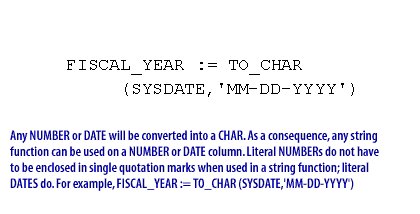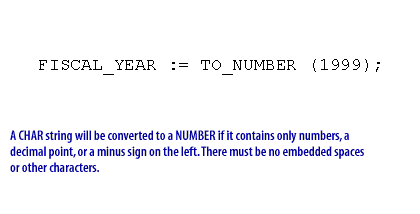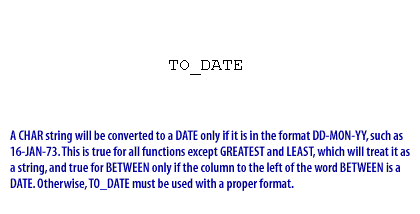| Lesson 6 | Explicit versus implicit datatype conversions |
| Objective | Identify implicit and explicit datatype conversions within PL/SQL. |
Explicit versus implicit Datatype Conversions
PL/SQL will automatically convert datatypes if the statement contains conflicting datatypes. For example, if you assign a number value to a
CHAR variable, PL/SQL will convert it into a character representation. The reverse is also true, provided the character expression can be converted to a valid numeric value. This is also true for DATE datatypes. This will not always work, however. To have PL/SQL automatically convert one datatype into another, the first datatype must already “look” like the datatype to which it is being converted.
Implicit Datatype Conversion
The following series of images describes the automatic conversation of data from one type to another.

FISCAL_YEAR := TO_CHAR(SYSDATE, 'MM-DD-YYY')


SIMPLE_INTEGER, SIMPLE_FLOAT, and SIMPLE_DOUBLE Data Types
The SIMPLE_INTEGER, SIMPLE_FLOAT, and SIMPLE_DOUBLE data types are predefined subtypes of
respectively. Each subtype has the same range as its base type and has a NOT NULL constraint.
A date will not be converted to a number, and vice versa.
Ad Oracle Database PL/SQL Programming
PLS_INTEGER, BINARY_FLOAT, and BINARY_DOUBLE,
respectively. Each subtype has the same range as its base type and has a NOT NULL constraint.
SIMPLE_INTEGER differs significantly from PLS_INTEGER in its overflow semantics, but SIMPLE_FLOAT and SIMPLE_DOUBLE are identical to their base types, except for their NOT NULL constraint. You can use SIMPLE_INTEGER when the value will never be NULL and overflow checking is unnecessary. You can use SIMPLE_FLOAT and SIMPLE_DOUBLE when the value will never be NULL. Without the overhead of checking for nullness and overflow, these subtypes provide significantly better performance than their base types when PLSQL_CODE_TYPE='NATIVE', because arithmetic operations on SIMPLE_INTEGER values are done directly in the hardware.
When PLSQL_CODE_ TYPE='INTERPRETED', the performance improvement is smaller.
A date will not be converted to a number, and vice versa.
Explicit Datatype Conversion
If you have mixed datatypes within your expression and you need to convert them explicitly, PL/SQL provides a wide variety of datatype conversion functions. You can use them to manipulate variables and data as well as within your Oracle SQL statements.
MAX and MIN are the only two group functions that can be used with any datatypes.
Conversion Table
The following table provides a bird's eye view of all the
- conversion functions and
- valid datatype conversions
| FROM/TO | CHAR | DATE | NUMBER | RAW | ROWID |
| CHAR | TO_DATE | TO_NUMBER | HEXTORAW | CHARTOROWID | |
| DATE | TO_CHAR | ||||
| NUMBER | TO_CHAR | TO_DATE | |||
| RAW | RAWTOHEX | ||||
| ROWID | ROWIDTOCHAR |
In the next lesson, operators within PL/SQL will be discussed.